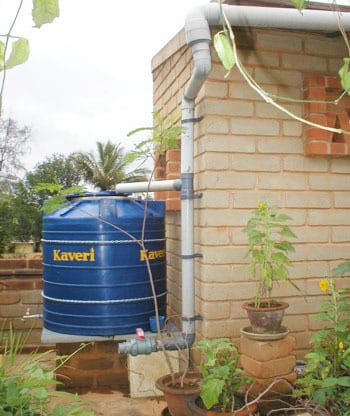Much has been written in recent years about rainwater harvesting. While the literature has certainly elevated interest in this practice, there is very little material to explain in simple terms how people can carry out an informed attempt to introduce RWH in their homes and communities.
This Citizen Matters 4-part series authored by Bangalore-based Rainwater Club shows the way to implementing rainwater harvesting in a particular context: the gated layout.
In the beginning
When residents move into their new homes in a layout, they are occupied with setting up the home and making sure their daily requirements of water, electricity, grocery and other services are met. There is a tendency to assume that the layout developer will ensure proper water management. And indeed they often do manage the water supply, for a time.

Rain barrel. Pic: Rainwater Club.
But more often than not, the developer either does not value sustainable resource management or does not know how to go about achieving it. Moreover, in the absence of a long-term maintenance contract, most developers leave the layout and control of all services in the hands of the residents after the last home has been built. At some point, concerned residents begin to recognize the critical importance of managing the layout’s water efficiently and effectively.
Given that layouts develop mostly on the city’s outer rings, they are off the public water utility’s service grid and must source their own water. Because there is no agency or company to depend upon to secure their future water supply, residents come to see responsible water management not as a choice, but an imperative to protect the investment they made on their new home.

Rooftop RWH. Pic: Rainwater Club.
Rainwater harvesting (RWH), including rooftop collection for domestic use and groundwater recharge, can be instrumental in efforts to achieve water sustainability. To implement this practice throughout the layout, committed residents must come together to carry out a process to familiarise residents with the RWH concept and generate support for it.
Before beginning this process, however, it is important to address some key issues that will arm you with the requisite information to make a strong case for sustainable water management to your fellow neighbours.
3 steps to preparing your RWH efforts
Step 1 – Ask yourself: Why Rainwater Harvesting?
It is important to understand the main objectives of rainwater harvesting in your layout since this will help determine the strategy and design of a Rainwater Harvesting system in
your specific context
- Is it a source of supplemental water (thus reducing demand from your existing sources)?
- Is it to recharge ground water sources as you are dependent on borewells/open wells?
- Is it also as a flood control measure?
Your answers to these questions will help determine the most appropriate RWH interventions. Indeed, in many cases RWH is implemented to achieve all three of these objectives.
Step 2 – What should be the RWH strategy for your layout
Another factor to consider when determining the best RWH interventions for your context is your layout’s land use pattern. In a typical urban residential layout, land use is usually as follows: approximately 60% is rooftops, 20% is roads and the rest is open-areas like parks, playgrounds, footpaths, transformer yards or drains.
This means that the largest amount of rain is falling on rooftops. Rooftops are also clean and so rainwater running off of them is clean. It is prudent to try and capture this at the household level and use it for domestic purposes, which will reduce dependence on other water sources during the rainy seasons. It is possible in most cases to retrofit households with RWH systems, though it is worth noting to those building a new home that the cost of domestic RWH systems is significantly lower when RWH is incorporated into a new home design.
Investment in domestic RWH is done at the individual household level. The harvested water can be stored in an existing sump, in a new storage tank or for recharge. Water stored in tanks can be used for all domestic purposes, though certain precautions and treatment is necessary if it is to be used for drinking and cooking (more about this in later parts of this series). Click here for information on the components and benefits of a domestic RWH system with storage tank, and here for background on RWH using an existing sump as storage.

Recharge well in stormdrain. Pic: Rainwater Club.
As for the 40% of rainfall not falling on rooftops, recharge wells are a valuable intervention to consider, as they can replenish the ground water supplying your layout’s borewells, and can also help with flood management. Recharge wells can be developed to collect run-off from common areas such as roads, parks, and storm drains. These investments will need to be made collectively. S. Vishwanath posted an informative recharge well video on YouTube.
Finally, one must consider the residents themselves and which interventions they may or may not support and why. Cost, upkeep and aesthetics are three key factors in people’s decisions to support or oppose a particular intervention.
One will usually not find the answers to these questions until they start asking.
Rainwater Club
rainwaterclub [at] gmail [dot] com
1022, 1st Floor, 6th Block, HMT Layout
Vidyaranyapura Main Road,
Vidyaranyapura,
Bangalore – 560 097
Office – 80416-72790
www.rainwaterclub.org
Step 3 – Talk to an expert
Consulting someone with technical RWH expertise can further clarify the most appropriate interventions for your layout and supply you with helpful information to share with other residents. Some source of good technical input and expertise can also assist with strategising, design and implementation. This can be sourced through the market from service providers, NGOs, individuals with expertise or others who have already done it.
A note of caution: RWH design is a deceptively complex science, and it is important you make sure the expert you consult understands the fundamentals. Our advice is to confirm that your expert has experience designing and implementing RWH. Ask for their track record of successful installations.
Then what?
Once you have an idea of what interventions you would like to pursue in your layout, you must enter a process of engagement with other layout residents to address various concerns and achieve clarity on all the benefits. How this process can be achieved will be covered in the Part 2 of this series.
Coming next
Part 2: Engaging with the people of the layout.
Part 3: Understanding the technology of storage and recharge – a FAQ on household RWH
Part 4: Creating an environment that incentivises RWH. ⊕
Addendum
About recharge wells and pits
1. What is a recharge pit? Is it the same as a recharge well?
A recharge pit is a hole dug in the ground. Usually it is filled with gravel or jelly to give it structural strength. A recharge well is not filled with gravel. It needs concrete rings installed in it to stabilise its walls.
2. What should be the depth of a recharge well/pit?
If you want to have effective recharge for Bangalore conditions, a 15-20 feet depth is needed. (Provided you do not hit rock before that depth). If you hit water while digging the pit, you need to ask the workers to be careful while they continue digging. The diameter of the pit you choose depends on two things: space available and the quantity of water you will send in. A 3 feet dia X 20 feet pit will ‘hold’ around 4000 litres (for recharging the ground). A 5 feet x 30 feet structure can hold 16000 litres.
3. What are the legal guidelines and their implication for recharge pit sizes?
The law states that you need to store or recharge 20 litres for for every sq.m of roof area and 10 litres for every sq.m of non-roof (ground surfaces such as parking, backyard) area. This is for plot sizes of 40×60 or more. For e.g. if your home has about 100 sq.ms of roof area, and about 50 sq.ms of non-roof area, then you will need to create capacity for at least 2500 litres of water. If you are using a 1000 litre tank to store rainwater for immediate use, you can connect the overflow to a 4000 litre (3 feet x 20 feet) recharge well.
4. How much do recharge pits cost?
Cost of digging a 3 feet diameter x 20 feet deep well is approximately Rs 20,000.
Avinash Krishnamurthy is a member of Rainwater Club.
Nice Coverage Poornima. Thanks for writing.
Thanks peevee.